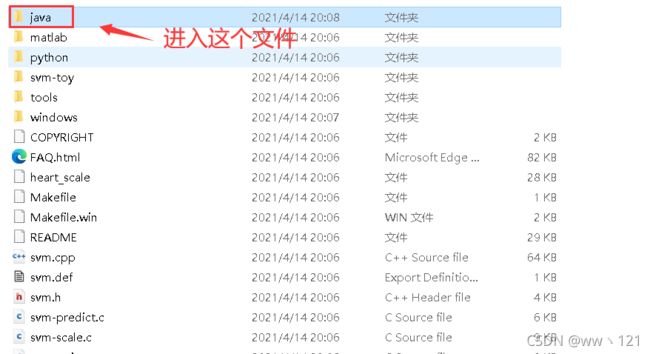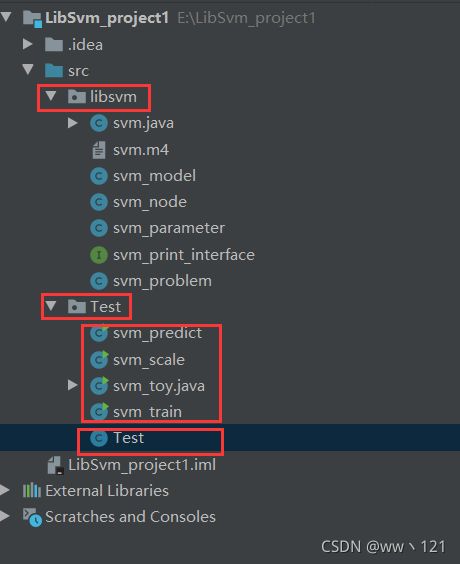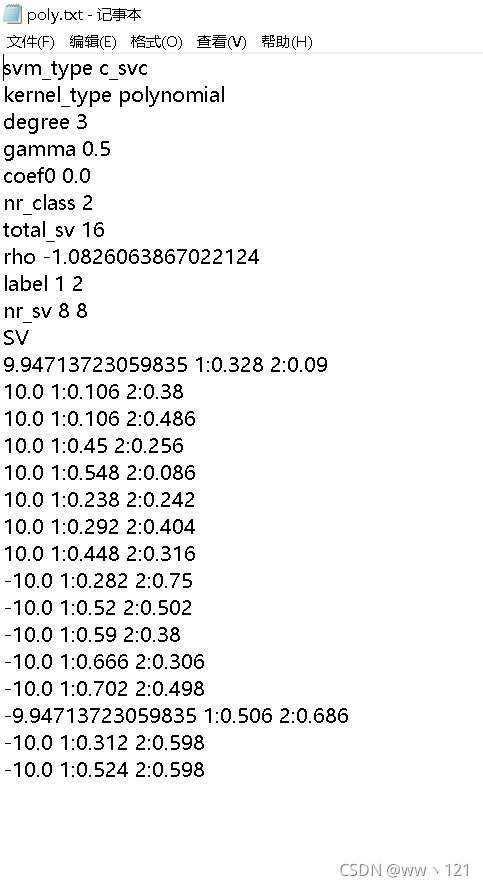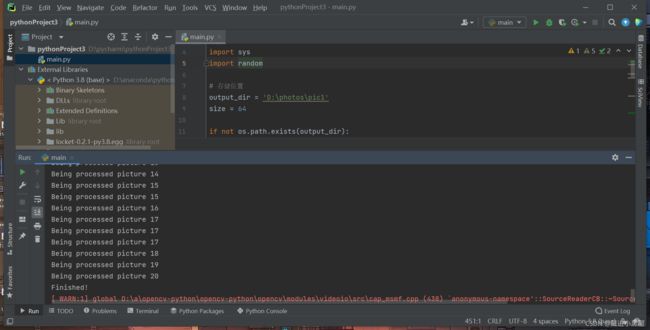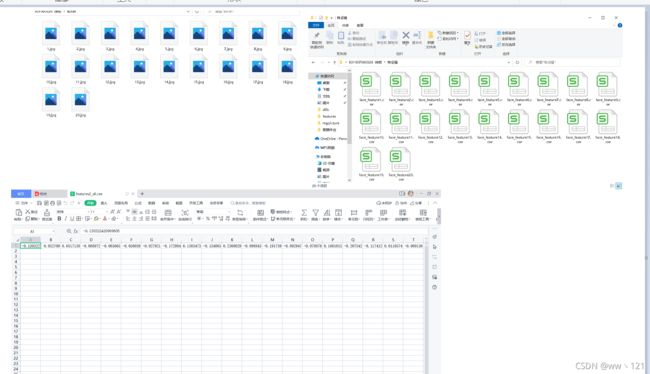【机器学习】机器学习之支持向量机(SVM)
目录
- 一、下载LibSVM
- 二、使用LibSVM工具准备数据
- 三、训练模型并写出决策函数的数学公式
- 四、参考文献
一、下载LibSVM
LibSVM官网
下载完成解压后得到文件目录如下:
 之后选择对应语言的代码:(这里我用的
之后选择对应语言的代码:(这里我用的JAVA)
二、使用LibSVM工具准备数据
选择windows文件夹,找到名为svm-toy.exe的运行程序并运行
手动绘制数据集的点:
在原有基础上再次添加一点数据,保存为test.txt。
三、训练模型并写出决策函数的数学公式
Test类:
package Test;
import java.io.IOException;
import java.sql.SQLOutput;
public class Test {
public static void main(String args[]) throws IOException {
String filepath = "E:\\LibSvm_project1\\";
String[] arg = {"-s","0","-c","10","-t","0",filepath+"train.txt",filepath+"text.txt"};
System.out.println("----------------线性-----------------");
svm_train.main(arg);
arg[5]="1";
arg[7]=filepath+"poly.txt";
System.out.println("---------------多项式-----------------");
svm_train.main(arg);
arg[5]="2";
arg[7]=filepath+"RBF.txt";
System.out.println("---------------高斯核-----------------");
svm_train.main(arg);
}
}
运行项目,结果如下:
输出文件:
- train.txt训练数据
- text.txt线性模型
- poly多项式模型
- RBF高斯核模型
数据说明
- svm_type //所选择的svm类型,默认为c_svc
- kernel_type //训练采用的核函数类型,此处为RBF核
- gamma //RBF核的参数γ
- nr_class //类别数
- total_sv //支持向量总个数
- rho //判决函数的偏置项b
- label //原始文件中的类别标识
- nr_sv //每个类的支持向量机的个数
- SV //各个类的权系数及相应的支持向量
线性模型

公式:f(x)=SV*x+rho
- wT为向量的转置矩阵,即为模型数据中的SV
- b为偏置常数,即为数据模型中的rho
四、参考文献
1.基于LibSVM得到决策函数
本文转自 https://blog.csdn.net/wanerXR/article/details/121410752,如有侵权,请联系删除。
- 一、人脸特征提取
- 二、获取每个人68个特征数据并保存到csv中
- 三、参考链接
环境:
pycharm专业版
python3.8
dlib19.19.0
一、人脸特征提取
人脸数据集
①使用摄像头采集(视频流截图)
采集的过程,最好使用同一设备同一光线下进行采集
import cv2
import dlib
import os
import sys
import random
# 存储位置
output_dir = 'D:/mypicture/picture/'
size = 64
if not os.path.exists(output_dir):
os.makedirs(output_dir)
# 改变图片的亮度与对比度
def relight(img, light=1, bias=0):
w = img.shape[1]
h = img.shape[0]
# image = []
for i in range(0, w):
for j in range(0, h):
for c in range(3):
tmp = int(img[j, i, c] * light + bias)
if tmp > 255:
tmp = 255
elif tmp < 0:
tmp = 0
img[j, i, c] = tmp
return img
# 使用dlib自带的frontal_face_detector作为我们的特征提取器
detector = dlib.get_frontal_face_detector()
# 打开摄像头 参数为输入流,可以为摄像头或视频文件
camera = cv2.VideoCapture(0)
index = 1
while True:
if (index <= 20): # 存储20张人脸特征图像
print('Being processed picture %s' % index)
# 从摄像头读取照片
success, img = camera.read()
# 转为灰度图片
gray_img = cv2.cvtColor(img, cv2.COLOR_BGR2GRAY)
# 使用detector进行人脸检测
dets = detector(gray_img, 1)
for i, d in enumerate(dets):
x1 = d.top() if d.top() > 0 else 0
y1 = d.bottom() if d.bottom() > 0 else 0
x2 = d.left() if d.left() > 0 else 0
y2 = d.right() if d.right() > 0 else 0
face = img[x1:y1, x2:y2]
# 调整图片的对比度与亮度, 对比度与亮度值都取随机数,这样能增加样本的多样性
face = relight(face, random.uniform(0.5, 1.5), random.randint(-50, 50))
face = cv2.resize(face, (size, size))
cv2.imshow('image', face)
cv2.imwrite(output_dir + '/' + str(index) + '.jpg', face)
index += 1
key = cv2.waitKey(30) & 0xff
if key == 27:
break
else:
print('Finished!')
# 释放摄像头 release camera
camera.release()
# 删除建立的窗口 delete all the windows
cv2.destroyAllWindows()
break
结果:
运行结果

在对应的输出目录下,会得到20张摄像头采集得到的图片。
二、获取每个人68个特征数据并保存到csv中
# 从人脸图像文件中提取人脸特征存入 CSV
# Features extraction from images and save into features_all.csv
# return_128d_features() 获取某张图像的128D特征
# compute_the_mean() 计算128D特征均值
from cv2 import cv2 as cv2
import os
import dlib
from skimage import io
import csv
import numpy as np
# 要读取人脸图像文件的路径
path_images_from_camera = "D:/mypicture/picture/"
# Dlib 正向人脸检测器
detector = dlib.get_frontal_face_detector()
# Dlib 人脸预测器
predictor = dlib.shape_predictor("D:\BaiduNetdiskDownload/shape_predictor_68_face_landmarks.dat")
# Dlib 人脸识别模型
# Face recognition model, the object maps human faces into 128D vectors
face_rec = dlib.face_recognition_model_v1("D:\BaiduNetdiskDownload/dlib_face_recognition_resnet_model_v1.dat")
# 返回单张图像的 128D 特征
def return_128d_features(path_img):
img_rd = io.imread(path_img)
img_gray = cv2.cvtColor(img_rd, cv2.COLOR_BGR2RGB)
faces = detector(img_gray, 1)
print("%-40s %-20s" % ("检测到人脸的图像 / image with faces detected:", path_img), '\n')
# 因为有可能截下来的人脸再去检测,检测不出来人脸了
# 所以要确保是 检测到人脸的人脸图像 拿去算特征
if len(faces) != 0:
shape = predictor(img_gray, faces[0])
face_descriptor = face_rec.compute_face_descriptor(img_gray, shape)
else:
face_descriptor = 0
print("no face")
return face_descriptor
# 将文件夹中照片特征提取出来, 写入 CSV
def return_features_mean_personX(path_faces_personX):
features_list_personX = []
photos_list = os.listdir(path_faces_personX)
if photos_list:
for i in range(len(photos_list)):
# 调用return_128d_features()得到128d特征
print("%-40s %-20s" % ("正在读的人脸图像 / image to read:", path_faces_personX + "/" + photos_list[i]))
features_128d = return_128d_features(path_faces_personX + "/" + photos_list[i])
# print(features_128d)
# 遇到没有检测出人脸的图片跳过
if features_128d == 0:
i += 1
else:
features_list_personX.append(features_128d)
i1 = str(i + 1)
add = "D:/mypicture/face_feature" + i1 + ".csv"
print(add)
with open(add, "w", newline="") as csvfile:
writer1 = csv.writer(csvfile)
writer1.writerow(features_128d)
else:
print("文件夹内图像文件为空 / Warning: No images in " + path_faces_personX + '/', '\n')
# 计算 128D 特征的均值
# N x 128D -> 1 x 128D
if features_list_personX:
features_mean_personX = np.array(features_list_personX).mean(axis=0)
else:
features_mean_personX = '0'
return features_mean_personX
# 读取某人所有的人脸图像的数据
people = os.listdir(path_images_from_camera)
people.sort()
with open("D:/mypicture/features/features2_all.csv", "w", newline="") as csvfile:
writer = csv.writer(csvfile)
for person in people:
print("##### " + person + " #####")
# Get the mean/average features of face/personX, it will be a list with a length of 128D
features_mean_personX = return_features_mean_personX(path_images_from_camera + person)
writer.writerow(features_mean_personX)
print("特征均值 / The mean of features:", list(features_mean_personX))
print('\n')
print("所有录入人脸数据存入 / Save all the features of faces registered into: D:/myworkspace/JupyterNotebook/People/feature/features_all2.csv")
三、参考链接
1.Dlib模型实现人脸识别
本文转自 https://blog.csdn.net/wanerXR/article/details/121412126,如有侵权,请联系删除。
